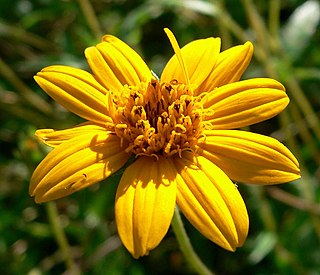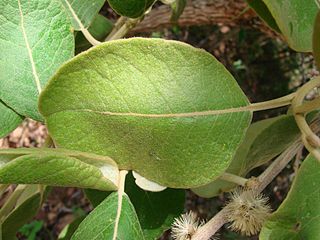
Cassia is a genus of flowering plants in the legume family, Fabaceae, and the subfamily Caesalpinioideae. Species are known commonly as cassias. Cassia is also the English common name of some species in the genus Cinnamomum of the family Lauraceae. Species of the genera Senna and Chamaecrista were previously included in Cassia. Cassia now generally includes the largest species of the legume subtribe Cassiinae, usually mid-sized to tall trees.

Eremanthus is a genus of plants belonging to the family Asteraceae. Species occur in Brazil and Bolivia.

Myrciaria is a genus of large shrubs and small trees described as a genus in 1856. It is native to Central and South America, Mexico, and the West Indies, with many of the species endemic to Brazil. Common names include hivapuru, sabará, and ybapuru.

Trixis is a genus of shrubs in the family Asteraceae, native to North and South America including the West Indies.

Polyscias is a genus of flowering plants in the family Araliaceae. They bear pinnately compound leaves.

Andira is a genus of flowering plants in the legume family, Fabaceae. It is distributed in the tropical Americas, except for A. inermis, which also occurs in Africa. It was formerly assigned to the tribe Dalbergieae, but molecular phylogenetic studies in 2012 and 2013 placed it in a unique clade within subfamily Faboideae named the Andira clade.

Pentacalia is a genus of flowering plants in the family Asteraceae. About 34 members of this genus appear to be located in the South American county Ecuador, where they are threatened by habitat loss. The genus contains approximately two hundred species, which are distributed from Mexico to northern South America.

Wedelia is a genus of flowering plants in the family Asteraceae. They are one of the genera commonly called "creeping-oxeyes".
Heterocondylus is a genus of Latin American flowering plants in the family Asteraceae.

Piptocarpha is a genus of flowering plants in the family Asteraceae. Ashdaisy is a common name for these plants.
Chresta pacourinoides is a species of flowering plants in the family Asteraceae. It was first described as Pithecoseris pacourinoides by A. P. de Candolle in 1836 with the name ascribed to Carl von Martius. Under this name, it was the only species in the genus Pithecoseris. Chresta pacourinoides is native to northeastern Brazil.
Proteopsis is a genus of flowering plants in the tribe Vernonieae within the family Asteraceae.

Vernonanthura is a genus of Neotropical plants in the tribe Vernonieae within the family Asteraceae.
Chrysolaena is a genus of flowering plants belonging to the family Asteraceae.
Clavija is a genus of flowering plants belonging to the family Primulaceae.
Zanthoxyloideae is a subfamily of the family Rutaceae.
Heterocoma ekmaniana is a species of flowering plant in the family Asteraceae. It is endemic to Brazil, and known from the states of Goiás and Minas Gerais.










